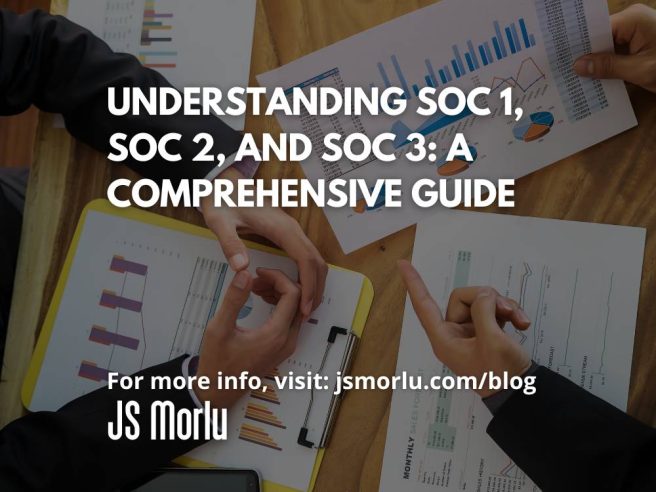By: John S. Morlu II, CPA
As organizations increasingly rely on outsourced services and cloud computing, concerns about data security, privacy, and compliance continue to grow. To address these concerns, the American Institute of Certified Public Accountants (AICPA) developed the Service Organization Control (SOC) framework. SOC reports provide a structured approach to evaluating and reporting on the internal controls of service organizations.
SOC reports are categorized into three types—SOC 1, SOC 2, and SOC 3—each serving distinct purposes and audiences. This article explores the purpose, scope, and audience of these reports, highlighting their importance for organizations and service providers alike.
What Are SOC Reports?
SOC reports are independent audits that evaluate a service organization’s controls, enabling stakeholders—clients, regulators, and partners—to assess their security, privacy, and operational integrity. By doing so, these reports help organizations demonstrate compliance with industry standards and build trust among stakeholders.
The three categories of SOC reports include:
- SOC 1: Focuses on financial reporting controls.
- SOC 2: Focuses on non-financial controls, such as security, availability, and privacy.
- SOC 3: A general-purpose summary report derived from SOC 2, intended for public consumption.
SOC 1: Reporting on Financial Controls
Purpose
SOC 1 reports evaluate controls that affect a service organization’s clients’ financial reporting. They are particularly relevant for organizations outsourcing key financial functions such as payroll or billing.
Focus Areas
SOC 1 reports assess controls impacting the accuracy, completeness, and reliability of financial data. These controls are closely aligned with the requirements of the Sarbanes-Oxley Act (SOX) and other financial reporting frameworks.
Types of SOC 1 Reports
1. Type I: Assesses the suitability of the design of controls at a specific point in time.
2. Type II: Evaluates the design and operational effectiveness of controls over a period, usually six months or longer.
Intended Audience
SOC 1 reports are designed for financial executives, auditors, and other stakeholders responsible for financial reporting. They are not intended for general distribution.
Examples of Use Cases
- A company outsourcing payroll to a third-party provider requires a SOC 1 report to verify compliance with financial reporting standards.
- A cloud service provider offering financial transaction processing obtains a SOC 1 report to ensure the reliability of its financial controls.
SOC 2: Reporting on Non-Financial Controls
Purpose
SOC 2 reports evaluate non-financial controls related to security, availability, processing integrity, confidentiality, and privacy. These reports are essential for organizations managing sensitive client data, such as SaaS providers and IT managed service companies.
Focus Areas
SOC 2 reports are based on the Trust Services Criteria (TSC), covering:
- Security: Protection against unauthorized access and breaches.
- Availability: Ensuring systems are operational and accessible as promised.
- Processing Integrity: Ensuring data processing is accurate and reliable.
- Confidentiality: Safeguarding sensitive information.
- Privacy: Adherence to privacy policies for handling personal information.
Organizations can customize SOC 2 reports to align with the specific criteria relevant to their operations.
Types of SOC 2 Reports
1. Type I: Assesses the suitability of control design at a specific point in time.
2. Type II: Evaluates both the design and operational effectiveness of controls over a period.
Intended Audience
SOC 2 reports are typically shared with clients, regulators, and stakeholders requiring assurance about a service organization’s non-financial controls. Access is usually restricted to relevant parties.
Examples of Use Cases
- A SaaS provider hosting client data on its platform uses a SOC 2 report to demonstrate compliance with security standards.
- An IT service provider offering disaster recovery solutions obtains a SOC 2 report to assure clients of its system availability.
SOC 3: General-Purpose Reporting
Purpose
SOC 3 reports provide a high-level summary of SOC 2 findings, offering assurance without disclosing detailed control descriptions or test results. They are ideal for marketing and transparency purposes.
Focus Areas
SOC 3 reports cover the same Trust Services Criteria as SOC 2 but omit detailed evaluations. They demonstrate an organization’s commitment to security and operational excellence.
Intended Audience
SOC 3 reports are designed for general audiences, including prospective clients, partners, and other stakeholders. Unlike SOC 1 and SOC 2, SOC 3 reports are suitable for public distribution.
Examples of Use Cases
- A cloud provider publishes a SOC 3 report to assure potential clients of its security practices.
- A healthcare IT provider uses a SOC 3 report in marketing materials to highlight compliance with industry standards.
Key Differences Between SOC 1, SOC 2, and SOC 3
| Aspect | SOC 1 | SOC 2 | SOC 3 |
| Focus | Financial reporting controls | Non-financial controls (e.g., security) | High-level summary of SOC 2 |
| Framework | Internal Control over Financial Reporting (ICFR) | Trust Services Criteria (TSC) | Trust Services Criteria (TSC) |
| Types | Type I, Type II | Type I, Type II | Not applicable |
| Audience | Auditors, financial executives | Clients, regulators, stakeholders | General public |
| Details Provided | Detailed | Detailed | Summary |
Why Are SOC Reports Important?
For Service Organizations
- Credibility and Trust: SOC reports enhance credibility by validating adherence to industry standards.
- Competitive Advantage: Clients and partners prefer organizations with SOC reports.
- Risk Mitigation: SOC audits identify control weaknesses, enabling proactive improvements.
For Clients and Stakeholders
- Assurance: SOC reports offer confidence in a service organization’s controls.
- Compliance: They help meet regulatory requirements, such as GDPR, HIPAA, and SOX.
- Risk Reduction: SOC reports mitigate risks related to data breaches or service disruptions.
Steps to Obtain a SOC Report
1. Understand the Requirements: Identify the appropriate SOC report based on services and client needs.
2. Engage a Qualified Auditor: Work with an experienced CPA or auditing firm.
3. Prepare for the Audit: Implement and document necessary controls.
4. Conduct the Audit: Undergo a thorough evaluation of controls.
5. Review and Address Findings: Address any deficiencies highlighted in the report.
Challenges in SOC Reporting
- Complexity: Implementing SOC-compliant controls can be challenging.
- Cost: SOC audits require significant financial investment.
- Resource Demands: Preparing for audits requires substantial time and effort.
Conclusion
SOC 1, SOC 2, and SOC 3 reports are critical tools for service organizations seeking to build trust, ensure compliance, and gain a competitive edge. Each report serves a unique purpose, addressing specific stakeholder concerns—whether related to financial reporting, data security, or operational transparency. By obtaining the appropriate SOC report, organizations demonstrate their commitment to excellence and strengthen relationships with clients and partners in today’s security-conscious environment.
Author: John S. Morlu II, CPA
John S. Morlu II, CPA, is the CEO and Chief Strategist of JS Morlu, a globally acclaimed public accounting and management consulting powerhouse. With his visionary leadership, JS Morlu has redefined industries, pioneering cutting-edge technologies across B2B, B2C, P2P, and B2G landscapes.
The firm’s groundbreaking innovations include:
• ReckSoft (www.ReckSoft.com): AI-driven reconciliation software revolutionizing financial accuracy and efficiency.
• FinovatePro (www.FinovatePro.com): Advanced cloud accounting solutions empowering businesses to thrive in the digital age.
• Fixaars (www.fixaars.com): A global handyman platform reshaping service delivery and setting new benchmarks in convenience and reliability.
Under his strategic vision, JS Morlu continues to set the gold standard for technological excellence, efficiency, and transformative solutions.
JS Morlu LLC is a top-tier accounting firm based in Woodbridge, Virginia, with a team of highly experienced and qualified CPAs and business advisors. We are dedicated to providing comprehensive accounting, tax, and business advisory services to clients throughout the Washington, D.C. Metro Area and the surrounding regions. With over a decade of experience, we have cultivated a deep understanding of our clients’ needs and aspirations. We recognize that our clients seek more than just value-added accounting services; they seek a trusted partner who can guide them towards achieving their business goals and personal financial well-being.
Talk to us || What our clients says about us




